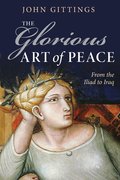The Glorious Art of Peace: From the Illiad to Iraq
By John Gittings
Oxford University Press, 2012
 Often relegated to a fringe area of the study of war, the subject of peace studies is marginalised as an even more specific sub-division of its militaristic counterpart. As a case in point, in the UK six universities offer various courses in the study of war whilst only one, Bradford, offers dedicated study of peace concepts. It is this imbalance that John Gittings’ book The Glorious Art of Peace: from the Iliad to Iraq aims to redress.
Often relegated to a fringe area of the study of war, the subject of peace studies is marginalised as an even more specific sub-division of its militaristic counterpart. As a case in point, in the UK six universities offer various courses in the study of war whilst only one, Bradford, offers dedicated study of peace concepts. It is this imbalance that John Gittings’ book The Glorious Art of Peace: from the Iliad to Iraq aims to redress.
Whilst not the first author to attempt this task, Gittings certainly brings new energy and insight to the subject in The Glorious Art of Peace. His career has spanned both academia and journalism, and the resultant book is both readable and informative in its discussion of the state of peace as a human phenomenon. With short, thematic chapters and coming in at roughly 250 pages overall, The Glorious Art of Peace manages to mix the authority of academic study with the readability of journalism to create a book that is thoroughly enjoyable.
Gittings begins his analysis in Ancient Greece and the Warring States period in China, highlighting the substantial counter cultures to peace at this time. This analysis is taken through the medieval Christian ideological battle of totally pacifistic Christianity (as shown by figures such as St Augustine) and a more militant, self defensive version (i.e. the Crusades), and then goes on to the Renaissance and the presentation of 17th century thinker Erasmus in contrast to the great Realist, Machiavelli. The journey is concluded by bringing the ‘story’ through the 20th century to the present day. Key to this discussion are the concepts of positive and negative peace. Negative peace is largely synonymous with a realist peace – i.e. states do not fight each other because they fear destruction – whilst positive peace is a much more empirical, conscious and permanent construct for the benefit of mankind. On its own this is a fascinating chronology of a global counter culture over the past two millennia; the central purpose of the book, however, is greater and more ambitious.
Gittings’ central position is that despite human prosperity and progress being largely dependent on peace, modern histories are dominated by the narratives of war. Historians such as Michael Howard (quoted in the text) are often quick to deride peace as something along the lines of ‘a nice idea, but unworkable’. Gittings argues that this academic imbalance and prejudice compounds the supposed veracity of the pessimistic realist dogma of expecting and preparing for the worst, creating a self-fulfilling prophecy of negativity in the international system. Empirically, this idea has been substantiated by the arms races that characterised the 20th century and the mass wars that scarred it.
Simply put, Gittings’ book is an attempt to highlight the culture and discipline of peace, to give it greater relevance and credibility. This is not only done through an idealistic lens but rather a pragmatic, results-driven approach. Among the examples he offers, individuals such as Gandhi stand out as effective arbiters of such campaigns waged for political results. A possible weakness of the book is that the occurrence of the Arab Spring, touched upon in the text, is another important development for the area which of course, cannot wholly be digested at present. As such a key and current political dynamic, which could have a significant effect on the development of peace studies in the 21st century, is conspicuously absent.
Furthermore, the book does little to safeguard itself from attacks by people such as Michael Howard who could be classified as ‘pseudo-idealist realists’. In other words, whilst it may be well-received by those who already believe that forms of pacifism are the way to proceed, Gittings may have difficulty persuading new adherents to the cause. For example, the book relies heavily on poetry and literature to expand the culture of peace that it creates; some might be quick to dismiss the content’s bearing upon the conduct of international politics. The extent to which Peace Studies is really a different subject to War Studies, rather than a derivative of it, could also undoubtedly be examined; for example, several concepts championed by Gittings – i.e. human security and global governance – are equally present in the liberal study of war.
Taken as a whole, The Glorious Art of Peace makes a strong case. Its closing statements – that in the 21st century ‘as globalisation breaks down the confines of the nation state a new obligation is placed upon governments to provide human security and good governance…across the whole world’ (p. 242) – is a poignant and astute assessment of the moral and pragmatic challenges that face diplomacy in the 21st century. Let us hope that more authors such as John Gittings strive to give Peace Studies the status is deserves within the field of International Relations.
—
Harry Booty is Associate Editor of e-IR. He is studying a BA War Studies degree at King’s College London.